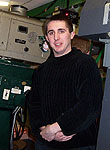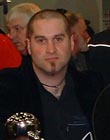|
|
This topic comprises 2 pages: 1 2
|
|
Author
|
Topic: Lens Sizes
|
Rob Jones
Film Handler

Posts: 44
From: Swindon, Wiltshire, United Kingdom
Registered: Jun 2001
|
 posted 05-26-2002 07:23 PM
posted 05-26-2002 07:23 PM





Hi,I'm just about to go and blow a fat load of cash on a nice new set of lenses. I'd rather not go and order the wrong sizes so if anyone has 2 minutes to check my calculations I'd be happy to buy them a drink  Screen dimensions x=7.68m, y=3.57m - approx 2.2:1 ratio.
Throw = 19.5m. I don't have the projector angle but its only a few degrees or so. So I'm going to work from a fixed height for 1.85:1 flat, and fixed width for 2.35:1 scope - this screen unfortunately has no masking  Scope comes out as 106mm focal length (image height=3.28m)
Flat comes out as 62mm (image width=6.58m) These are slightly different to the current lenses - the flat lens is 65mm which is pretty much there but the scope lens is 120mm - which would give us a smaller image - however the projected image size just about fills the screen as per the calculations for the 106mm lens. I think the varomorph (door stop?) might have something to do with it - either that or I got the numbers wrong! Rob
| IP: Logged
|
|
|
|
Paul G. Thompson
The Weenie Man

Posts: 4718
From: Mount Vernon WA USA
Registered: Nov 2000
|
 posted 05-26-2002 10:30 PM
posted 05-26-2002 10:30 PM




....or: Throw divided by the height of the image on the screen, then multiply that by the aperature size. Example: Throw = 60 feet
Desired image height on the screen = 14 feet.
60 divided by 14 = 4.285 4.285 times .446 (for flat) = 1.911 inch lens.
4.285 times .700 (for scope) = 2.999 inch lens. Works the same for scope, too, but remember the aperature size is .690, .700, or .715 - whatever ratio you are going to use. To convert the lens size (in inches) to millimeters, multiply the lens size (in inches) by 25.4, and you will see that the 1.911 inch lens is actually a 48.53 mm lens. A 2.999 inch lens times 25.4 will calculate to a 76.17mm lens. Use your aspect ratios to calculate the picture widths. Your 3.57 meter screen height is 11.713 feet. Your throw of 19.5 meters is 63.976 feet. The flat lens calculates to 61.87mm for a .446 aperature.
The scope lens calculates to 97.11mm for scope using a .700 aperature. Remember you can "fudge" this a little, since they don't make a 61.87mm lens, nor do they make a 97.11mm lens, either. If I recall correctly, lens sizes come in 2.5mm increments. My calculations should be correct, unless I had my fingers in the "wrong hole" on my handy TI-83 calculator. Please check my figures.
| IP: Logged
|
|
|
|
|
|
Paul G. Thompson
The Weenie Man

Posts: 4718
From: Mount Vernon WA USA
Registered: Nov 2000
|
 posted 05-27-2002 12:17 AM
posted 05-27-2002 12:17 AM




Gordon, Mags are cool, if used in the correct application. I don't see the necessity for Rob. His throw is long enough where he can very easily get by with a nominal size lens for both flat and scope. If Rob has an older auto lense changer, a magnacom might be needed. Frank, I understand the orginal reason for 1.85 ratio was to get away from the television look as much as possible in the 1950's. I have heard many times the 1.85 was called the "Bastard Ratio" because nothing would fit it.
| IP: Logged
|
|
Pete Naples
Phenomenal Film Handler

Posts: 1565
From: Dunfermline, Scotland
Registered: Feb 2001
|
 posted 05-27-2002 03:06 AM
posted 05-27-2002 03:06 AM




HmmmmmmmYour 'Scope is the awkward one. To fill the screen height, you are going to have to crop the sides by quite a bit, if you don't fill teh height you can shopw the whole 'Scope picture, but you run the risk of showing neg flashes if the plates aren't cut VERY carefully. Also I hate seeing unused, unmaskes screen surface. Perhaps this is why someone installed a Varamorph, by adjusting the squeeze you could get the picture to fit the screen, without losing any of it. Albeit with some distortion. I've seen it done and it looks a bit like some of those dodgy Sunday afternoon Westerns on BBC2! Based on the information you gave, and assuming a 5 degree downward rake, I get the following. 'Scope 2.39:1 95mm, 8.53m x 3.63m, cropping sides quite severaly.
1.85:1 60mm, 6.75m x 3.71m
1.66:1 70mm, 5.79m x 3.54m This is based on the readily available IscoOptic lenses. There are inbetween sizes available from Schneider, which may give a slightly more accurate result. Stick to Isco or Schneider lenses though, they are worth the extra cash over the other brands around. Question: How did you derive the throw? Is it screen to gate? Download yourself the Schneider or Isco programs and take a look for yourself too.
| IP: Logged
|
|
|
|
Steve Guttag
We forgot the crackers Gromit!!!

Posts: 12814
From: Annapolis, MD
Registered: Dec 1999
|
 posted 05-27-2002 09:15 AM
posted 05-27-2002 09:15 AM




There are many nice things about the Schneider lens program. The ability to see it as it will be is certainly one of them.The throw is always from the gate to the screen. On the Schneider program it is the straight line throw, then tell it where your projector is in relation to the screen (how high and to what side). It will give you a very accurate dipiction of what you picture will look like. If you are curving the screen, there is a glitch in it. You will need to add in the cord-depth to your throw so if you had say a 50 foot throw on a flat screen and you curve it 2 feet deep, you will need to make your throw 52 feet. As to hand calculations and slide rules...if you know what you are doing with them, you can come away with just as good a result. With them you should use a throw that goes from gate aperture to center of screen...if you have to go to bottom of screen you will need to use some trig. to calculate what the throw to center of screen is. As to focal lengths...Schenider's variable primes are for those people that just don't want to crop the picture. Admittedly, with the 2.5mm increments now available on shorter focal lengths, it isn't so bad anymore. Still the Schneider variable prime is a good way to have a perfect lens size without paying a performance penalty. Magnacoms and zoom converters still have their place in the world too. They offer a greater range than most and can provide the desired affect on the image. For instance on a curved screen that is optimized for maximum light reflectance, a magnacom can often provide the best image. Steve ------------------
"Old projectionists never die, they just changeover!"
| IP: Logged
|
|
Rob Jones
Film Handler

Posts: 44
From: Swindon, Wiltshire, United Kingdom
Registered: Jun 2001
|
 posted 05-27-2002 10:20 AM
posted 05-27-2002 10:20 AM





Hi,Thanks for the many suggestions. Pete, could the varomorph have been reducing the effective focal length of the system? The backing lens was 120mm but the Varomorph is only ever set to a horizontal expansion of 2 which should give the right ratio. Whatever... its going in the skip anyhow  I've stuck the numbers (they were measured with a tape measure so should be reaonably accurate) into both Isco and Schneider's software and they both come back with 60mm for 1.85:1. Pete, you were right, Scope was a bit awkward, but the amount of necessary cropping with the 95mm lens seemed a bit extreme - P"aramount picture"s comes to mind! Projector is almost dead centre horizontally (counting ceiling tiles) and the vertical offset wasn't great enough to make any big difference. In the end 105mm seemed to be a reasonable compromise - a little bit of an overshoot at the sides, a bit of space at the top and bottom, but adding on a couple of feet extra from the port to the gate makes it just about fit - went with the Isco Ultra MC for 1.85:1 and the Schneider super-cinelux anamorphic combo for scope. Rob
| IP: Logged
|
|
|
|
|
|
Steve Guttag
We forgot the crackers Gromit!!!

Posts: 12814
From: Annapolis, MD
Registered: Dec 1999
|
 posted 05-27-2002 12:13 PM
posted 05-27-2002 12:13 PM




If you are going with new lenses...consider the ISCO anamorphics. The BLUE-STAR really is 2nd to none by quite a margin. Schneider is still using 4-element anamorphics which seems to muck with their 2:1 expansion and often has focus compromises. Even the Ultra-Star anamorphic is a 5-element that has notably improved focus and reduced chromatic abberations. I also recommend staying away from integrated anamorphics if at all possible...I get better results from the full sizes. One thing the Schneider program does is accurately show how their lenses will perform in real life. Check out what happens when you use one of their "WA" anamorphics or "ES" series anamorphics are used vs. just a theoretical 2:1 expansion...The "WA" anamorphic is often greater than 2:1. Steve ------------------
"Old projectionists never die, they just changeover!"
| IP: Logged
|
|
|
|
|
|
|
|
All times are Central (GMT -6:00)
|
This topic comprises 2 pages: 1 2
|
Powered by Infopop Corporation
UBB.classicTM
6.3.1.2
The Film-Tech Forums are designed for various members related to the cinema industry to express their opinions, viewpoints and testimonials on various products, services and events based upon speculation, personal knowledge and factual information through use, therefore all views represented here allow no liability upon the publishers of this web site and the owners of said views assume no liability for any ill will resulting from these postings. The posts made here are for educational as well as entertainment purposes and as such anyone viewing this portion of the website must accept these views as statements of the author of that opinion
and agrees to release the authors from any and all liability.
|

 Home
Home
 Products
Products
 Store
Store
 Forum
Forum
 Warehouse
Warehouse
 Contact Us
Contact Us




 Printer-friendly view of this topic
Printer-friendly view of this topic

















